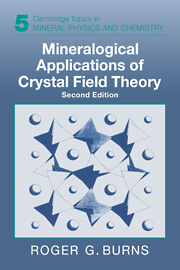Book contents
- Frontmatter
- Contents
- Preface to the first edition
- Preface to the second edition
- 1 Introduction
- 2 Outline of crystal field theory
- 3 Energy level diagrams and crystal field spectra of transition metal ions
- 4 Measurements of absorption spectra of minerals
- 5 Crystal field spectra of transition metal ions in minerals
- 6 Crystal chemistry of transition metal-bearing minerals
- 7 Thermodynamic properties influenced by crystal field energies
- 8 Trace element geochemistry: distribution of transition metals in the Earth's crust
- 9 Mantle geochemistry of the transition elements: optical spectra at elevated temperatures and pressures
- 10 Remote-sensing compositions of planetary surfaces: applications of reflectance spectra
- 11 Covalent bonding of the transition elements
- Appendices
- References
- Subject index
6 - Crystal chemistry of transition metal-bearing minerals
Published online by Cambridge University Press: 23 November 2009
- Frontmatter
- Contents
- Preface to the first edition
- Preface to the second edition
- 1 Introduction
- 2 Outline of crystal field theory
- 3 Energy level diagrams and crystal field spectra of transition metal ions
- 4 Measurements of absorption spectra of minerals
- 5 Crystal field spectra of transition metal ions in minerals
- 6 Crystal chemistry of transition metal-bearing minerals
- 7 Thermodynamic properties influenced by crystal field energies
- 8 Trace element geochemistry: distribution of transition metals in the Earth's crust
- 9 Mantle geochemistry of the transition elements: optical spectra at elevated temperatures and pressures
- 10 Remote-sensing compositions of planetary surfaces: applications of reflectance spectra
- 11 Covalent bonding of the transition elements
- Appendices
- References
- Subject index
Summary
A great deal has been written about the crystal-field model for first-row transition metal cations in the distorted octahedra of olivines. – – Its predictions are useful for – – rationalizing the intra- and inter-crystalline cation partitioning.
G. E. Brown Jr, Rev. Mineral, 5 (2nd edn), 333 (1982)Introduction
The crystal chemistry of many transition metal compounds, including several minerals, display unusual periodic features which can be elegantly explained by crystal field theory. These features relate to the sizes of cations, distortions of coordination sites and distributions of transition elements within the crystal structures. This chapter discusses interatomic distances in transition metal-bearing minerals, origins and consequences of distortions of cation coordination sites, and factors influencing site occupancies and cation ordering of transition metals in oxide and silicate structures, which include crystal field stabilization energies
Interatomic distances in transition metal compounds
One property of a transition metal ion that is particularly sensitive to crystal field interactions is the ionic radius and its influence on interatomic distances in a crystal structure. Within a row of elements in the periodic table in which cations possess completely filled or efficiently screened inner orbitals, there should be a decrease of interatomic distances with increasing atomic number for cations possessing the same valence. The ionic radii of trivalent cations of the lanthanide series for example, plotted in fig. 6.1, show a relatively smooth contraction from lanthanum to lutecium.
- Type
- Chapter
- Information
- Mineralogical Applications of Crystal Field Theory , pp. 240 - 271Publisher: Cambridge University PressPrint publication year: 1993



